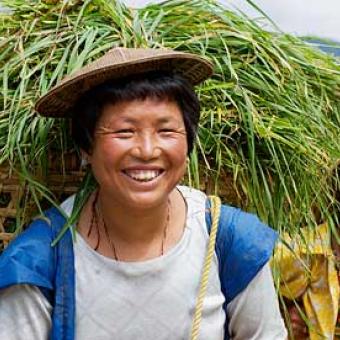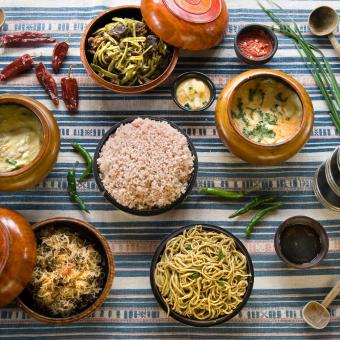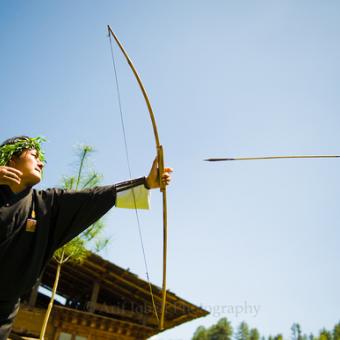History
According to archeological artefacts unearthed so far Bhutan was inhabited and existed 4000 years ago. Ancient stone implements and other archaeological findings indicate that there were settlements in Bhutan dating back to 2000 B.C. These early inhabitants were followers of Bon, an animistic tradition that was the main religion of the Himalayan region before advent of Buddhism. The chronicled history of the Kingdom however begins with the advent of Buddhism in the 8th century. In 747, A.D., the Buddhist sage Padmasambhava, popularly revered in Bhutan as Guru Rimpoche or the Precious Master, visited the country and introduced Buddhism. Since then, Buddhism has played a predominant role in shaping the social, political, economic and cultural evolution of the country. In the centuries that followed, Lamas or Buddhist teachers and local nobility established their own separate domains throughout the country.
Another important chapter in Bhutanese history unfolded in the early part of the 13th century when the Buddhist teacher, Phajo Drugom Zhigpo, introduced the Drukpa Kagyu school of Mahayana Buddhism in the western Bhutan. Over the years many other saints and religious figures helped shape Bhutan's history and develop its religion. The most dynamic era in Bhutanese history came in the 17th century with the arrival of Shabdrung Ngawang Namgyal (1594-1652), a leader of the Drukpa Kargyu School of Buddhism. Shabdrung was born in 1954 at Gor-gong in Tibet in the family of prince-abbots and was installed as the 18th prince-abbot of the Drukpa monastery at Ralung in 1606. following, theological and succession disputes about him, he was forced into exile to Bhutan in 1616. During his 35 year reign,Shabdrung consolidated the country under a unified power, constructed several important Dzongs (fortress), monasteries, and religious institutions and firmly established Drukpa Kargyu as the state religion, established the foundations for national governance and the Bhutanese identity that he came to be known as the founder of Druk Yul as a nation.
After the demise of Shabdrung Ngawang Namgyal, the country was torn with civil strife until 1907 when Gongsar Ugyen Wangchuck was unanimously elected by all regional governors and the central monastic body to be the First Hereditary King of Bhutan. The establishment of monarchy ushered in an era of peace and stability and most significantly unified the country under a central authority. It also set in motion a process of contact with the outside world and laid the foundation for the country as a modern nation state.
Over the years, the Kings of Bhutan have taken the country and its people into the 21st century, transforming a subsistence farming society into a modern nation. Bhutanese people are now on the path to democracy, a revolutionary move initiated from the throne, the Fourth King Jigme Singye Wangchuck. But monarchy remains the soul of the Bhutanese nation and will continue to be a vital institution in a rapidly changing society. The Kings of Bhutan are known for their selflessness, dynamism, farsightedness and love for their people. The institution of monarchy has attained its highest level. The King is the primary symbol of national unity and peace and harmony.
Bhutan at a Glance
| Total Area: | 38,394 square kilometers (about 300km long and 150km wide) |
| Location: | Landlocked between China (Tibet) and India |
| Altitude: | 100m above sea level in the South to over 7,500 m. above sea level in the North. |
| Population: | 745,153 (2014) : 387,520male and 357,633 female. |
| Language: | Originally spoken only in western Bhutan, Dzongkha is now the national language. English is widely spoken in main towns and it is the medium of education in secular schools while Choekey, classicalDzongkha is used in traditional and monastic schools. Local people are also familiar with Hindi and Nepali. |
| Political System: | Democratic Constitutional Monarchy |
| State Religion: | Drukpa sect of Kargyupa, a branch of Mahayana Buddhism. |
| Capital: | Thimphu |
| Time: | 6 hours ahead of Greenwich Mean Time (GMT+6) and half an hour ahead of Indian Standard Time (IST) |
| Terrain: | It can be divided into three major geographic regions from North to South; the high Himalayas of North, the hills and valleys of the central and the foothills and plains of the South. |
| Longitude: | 26 45’ - 28 15’ North |
| Country code: | 975 |
National Tree: Cypress
National Flower: Blue Poppy
National Bird: Raven
National Sports: Archery
National Animal: Takin
Tradition and Culture
Gross National Happiess
Three factors have exerted great influence on the course of Bhutan’s development. The first being continuous culture. As Bhutan was never conquered or colonized, the country developed a culture relatively fee from outside influence, the institution of monarchy, and deep sense of nationhood. The second factor is the environment, which is protected by mountains, often difficult terrain. Thirdly, Vajrayana Buddhism has given the country a view of the world on which the Third and Forth Kings based their policies of developing Bhutan’s potential in every field. This continuing development of Bhutan has been crystallized in a philosophy crafted by the Fourth King of Bhutan, His Majesty Jigme Singye Wangchuck, known as Gross National Happiness (GNH) in the late 1980s. The concept of GNH defines Bhutan’s development objective as improvement in the happiness and satisfaction of the people rather than growth of Gross National Product (GNP). GNH has been the overarching development philosophy of Bhutan as the concept has guided the country’s development policies and programmes. GNH suggests that happiness is the ultimate objective of development. It recognizes that there are many more dimensions to development than those associated with Gross National Product (GNP), and that development should be understood as a total process that seeks to maximize happiness rather than purely economic growth.
The country believes that for a holistic development of the individual and society, it is essential that development achieves a sustainable balance between the economic, social, emotional, spiritual and cultural needs of the people. This has led to the declared objective of viewing development as a continuous process towards maintaining balance between the material and the intangible needs of individuals and society. The concept reminds the country that the means must always be considered in terms of the end and, therefore, every step in material development and change must be measured and evaluated to ensure that it will lead to happiness, not just more development.
Environment
Flora
The government’s policy is to maintain 60% of the land under forest cover at all times. The present ratio is higher, with a remarkable 72% of the country covered in forests of fir, mixed conifers, temperate and broadleaf species. Bhutan’s forests also has 7000 vascular plants, 360 orchid species, 46 species of rhododendron, and other rare and endemic species, including over 500 species of medicinal plants. Flowers being rare and therefore considered very valuable in the European Alps such as Edelweiss are growing in thousands in Bhutan. It is a true biodiversity haven for nature lovers and specialists that Botanists Floraconsider the whole country as one beautiful park.
Fauna
Bhutan has been identified as one of the 10 bio-diversity hotspots in the world, harbouring an estimated 770 species of birds which includes the plumage, the Himalayan griffin, the unique high- altitude wader, the ibis bill, the spectacular hornbill, barbets, sunbirds, fulvattas, yuhinas, cuckoos, and many more. The country also has a great variety of endangered species like the black- necked crane, the monal pheasant, peacock pheasant, raven and the Rufous- necked hornbill. Along its southern border, the narrow tropical and subtropical belt supports the Asiatic elephant, greater one-horned rhinoceros, gaur, wild water buffalo, hog deer, tiger, clouded leopard, hornbill, trogon and other mammals and birds characteristic of indomalayan species. Only 150 kilometers to the north, high Himalayan fauna include the blue sheep, takin, musk deer, snow leopard, wolf and other species characteristic of the Palearctic realm. Bhutan is also known for its wintering populations (about 350 birds) of the vulnerable black-necked crane in the valleys of Phobjikha, Bomdeling and Gyetsa.
Geography
The northern region of Bhutan consists of an arc of glaciated mountain peaks with an extremely cold climate at the highest elevations. Most peaks in the north are over 23,000 feet (7,000 m) above sea level with the highest point being Gangkhar Puensum, which has the distinction of being the highest unclimbed mountain in the world, at 24,835 feet (7,570 m). The Black Mountains in central Bhutan form a watershed between two major river systems: the Mo Chhu and the Drangme Chhu. Peaks in the Black Mountains range between 4,900 feet and 8,900 feet (1,500 m and 2,700 m) above sea level, and fast-flowing rivers have carved out deep gorges in the lower mountain areas. Woodlands of the central region provide most of Bhutan's forest production. The Torsa, Raidak, Sankosh, and Manas are the main rivers of Bhutan, flowing through this region. Most of the population live in the central highlands.
In the south, the Shiwalik Hills are covered with dense, deciduous forests, alluvial lowland river valleys, and mountains up to around 4,900 feet (1,500 m) above sea level. The foothills descend into the subtropical Duars Plain. Most of the Duars is located in India, although a 6–9 mile (10–15 km) wide strip extends into Bhutan. The Bhutan Duars is divided into two parts: the northern and the southern Duars. The northern Duars, has rugged, sloping terrain and dry, porous soil with dense vegetation and abundant wildlife while the southern Duars has moderately fertile soil, heavy savannah grass, dense, mixed jungle, and freshwater springs. Mountain rivers, fed by either the melting snow or the monsoon rains, empty into the Brahmaputra River in India.
Climate
The climate in Bhutan varies with altitude, from subtropical in the south to temperate in the highlands and polar-type climate, with year-round snow, in the north. Bhutan experiences five distinct seasons: summer, monsoon, autumn, winter and spring. Western Bhutan has the heavier monsoon rains; southern Bhutan has hot humid summers and cool winters while central and eastern Bhutan is temperate and drier than the west with warm summers and cool winters. The northern region has severe alpine climate and is perpetually under snow. Rainfall can differ within relatively short distances due to rain shadow effects.
Festivals
Bhutan is a country of festivals. The most important are the religious dance festivals, known as Tshechus, which are held in different districts, at specific times during the year. It is celebrated for three to five days. These festivals are held in the honor of Guru Rinpoche (the saint who brought Buddhism to Bhutan and the Himalayan world) to commemorate his great deeds. Rare dances and sword dances are performed in the courtyards and temples of the Dzongs. The origin of most of the dances can be traced beyond the Middle Ages and are only performed once or twice a year. Each dance has its own significance and is performed by monks and villagers dressed in bright costumes. Many visitors come to Bhutan to witness these festivals held annually throughout the country. The most popular for tourists are those held in Paro during spring, Thimphu and Bumthang in autumn. The Tshechus are important religious festivals and it is believed that by attending them one gains merits and blessings. They are not somber formal religious affairs, but occasions to get together, renew acquaintances and make merry. The atsaras (traditional clowns of the Tshechu) add colour and merriment to the festival by their bawdy antics.
Each valley has is own special celebrations and guardian deities. The high point of the year is the Tshechu- a religious dance festival held in their honour. The Tshechu at Bumthang is well-known for taking place almost entirely during the night and containing exciting fire dances which are intended to help the childless women at the festival conceive during the forthcoming year. Tshechus attract crowds that sometimes travel from the remotest of villages. In a swirl of colour and nice, the gods and demons of Buddhist mythology come to life. The colourful ceremonies, religious theatre and exorcism ritual, are the most striking testimonies to the deep-rooted faith of Bhutan’s society.
| Sl. No. | Festival | Place | Dates |
|---|---|---|---|
| 1 | Bhutan International Marathon | Annual Event organized by (BOC) | 23rd February |
| 2 | Punakha Drubchen | Punakha Dzong, Punakha | 23rd – 27th February |
| 3 | Punakha Tshechu | Punakha Dzong, Punakha | 28th February – 2nd March |
| 4 | Tharpaling | Tharpaling Lhakhang, Chummi | 5th March |
| 5 | Chhorten Kora | Chorten Kora, Trashiyangtshe | 5th March & 20th March |
| 6 | Gomphukora | Gom Kora Lhakhang, Trashigang | 27th – 29th March |
| 7 | Talo Tshechu | Talo Gonpa, Punakha | 27th – 29th March |
| 8 | Gasa Tshechu | Gasa Dzong, Gasa | 27th – 30th March |
| 9 | Zhemgang Tshechu | Zhemgang Dzong, Zhemgang | 27th – 30th March |
| 10 | Peling Tshechu | Wangdichoeling Palace, Bumthang (New Festival) | 27th – 31st March |
| 11 | Paro Tshechu | Rinpung Dzong, Paro | 31st March – 4th April |
| 12 | Rhododendron Festival | Lamperi Botanical Garden, Dochula, Thimphu | 18th – 20th April |
| 13 | Domkhar Tshechu | Domkhar, Chummi, Bumthang | 28th – 30th April |
| 14 | Ura Yakchoe | Ura Lhakhang, Bumthang | 30th April – 4th May |
| 15 | Nimalung Tshechu | Nimalung Dratshang, Chummi, Bumthang | 24th – 26th June |
| 16 | Kurjey Tshechu | Kurjey Lhakhang, Choekhor, Bumthang | 26th June |
| 17 | Haa Summer Festival | Town Festival Ground, Haa | 5th July |
| 18 | Masutaki Mushroom Festival | Ura, Bumthang | 22nd– 23rd August |
| 19 | Tour Of The Dragon (Bicycle Race) | Bumthang To Thimphu | 5th September |
| 20 | Thimphu Drubchen | Tashi Chhodzong, Thimphu | 19th September |
| 21 | Wangdue Tshechu | Tencholing Army Ground, Wangduephodrang | 21st – 23rd September |
| 22 | Gangtey Tshechu | Gangtey Gonpa, Phobjikha, Wangduephodrang | 26th – 28th September |
| 23 | Tamshing Phala Chhoepa | Tamshing Lhakhang, Choekhor, Bumthang | 23rd – 25th September |
| 24 | Thimphu Tshechu | Tashi Chhodzong, Thimphu | 23rd – 25th September |
| 25 | Thangbi Mani | Tangbi Lhakhang, Choekor, Bumthang | 27th – 29th September |
| 26 | Chhukha Tshechu | Chhukha Dzong, Chhukha | 20th – 22nd October |
| 27 | Jakar Tshechu | Jakar Dzong, Choekhor, Bumthang | 21st – 23rd October |
| 28 | Pemagatshel Tshechu | Pemagatshel Dzong, Pemagatshel | 25th – 27th October |
| 29 | Jambay Lhakhang Drup | Jambay Lhakhang, Choekhor, Bumthang | 27th – 30th October |
| 30 | Prakhar Duchhoed | Prakar Lhakhang, Chummi, Bumthang | 28th – 30th October |
| 31 | Black Necked Crane Festival | Gangtey Gonpa, Phobjikha, Wangduephodrang | 11th November |
| 32 | Mongar Tshechu | Mongar Dzong, Mongar | 18th – 21st November |
| 33 | Trashigang Tshechu | Trashigang Dzong, Trashigang | 19th – 22nd November |
| 34 | Jambay Lakhang Singye Cham | Jambay Lhakhang, Choekhor, Bumthang | 25th November |
| 35 | Nalakhar Tshechu | Ngaa Lhakhang, Choekhor, Bumthang | 25th – 27th November |
| 36 | Druk Wangyel Tshechu | Dochula, Thimphu | 13th December |
| 37 | Trongsa Tshechu | Trongsa Dzong, Trongsa | 20th – 22nd December |
| 38 | Lhuentse Tshechu | Lhuentse Dzong, Lhuentse | 20th – 22nd December |
| 39 | Nabji Lhakhang Drup | Nabji Lhakhang, Nabji, Trongsa | 25th – 27th December |






